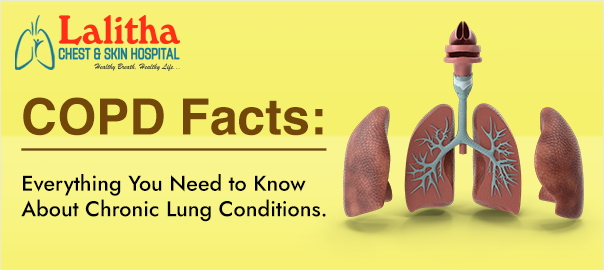COPD is a chronic lung disease caused by long-term exposure to irritants like cigarette smoke. It leads to breathing difficulties due to damaged airways and air sacs. Symptoms of COPD include coughing, wheezing, shortness of breath, and chest tightness.
“There’s no cure, but treatments like medications and lifestyle changes can manage symptoms and improve quality of life,” says Dr. Raj Kumar Korra, a chest specialist. But what exactly is COPD, how does it manifest in patients, and how can one prevent it? Every patient must be aware of this silent yet deadly disease.
With inputs from the best lung doctor in Karimnagar, Dr. Raj Kumar Korra, we aim to improve awareness about this condition in our blog here. Today, we dive into the types of COPD, their causes, symptoms, preventive tips, and also treatment options. Read on:
Types of COPD:
COPD is commonly divided into two main types: Chronic Bronchitis and Emphysema.
Chronic bronchitis: Involves long-term inflammation of the bronchial tubes, leading to increased mucus production and a persistent cough.
Emphysema is marked by damage to the air sacs (alveoli) in the lungs, reducing their elasticity and hindering airflow, leading to difficulty exhaling air from the lungs.
These conditions often overlap in individuals with COPD and present a range of symptoms and severity. Identifying the specific type is crucial for tailoring treatment plans to effectively manage symptoms and improve the patient’s quality of life.
What causes COPD?
COPD is primarily caused by smoking, but environmental factors like air pollution and genetic predisposition also play significant roles in its development.
- Smoking:
- Cigarette smoke is the primary cause of COPD.
- Smoking damages lung tissue and leads to inflammation and scarring.
- Heavy and prolonged smoking significantly increases COPD risk.
- Second-hand smoke:
- Inhaling smoke from others’ cigarettes can also cause COPD.
- Non-smokers exposed to second-hand smoke are at risk, especially in enclosed spaces.
- Environmental pollution:
- Air pollution from vehicles, industrial emissions, and burning of fossil fuels.
- Exposure to particulate matter and harmful gases contributes to lung damage.
- Genetic factors:
- Alpha-1 Antitrypsin Deficiency: A genetic condition predisposing to COPD.
- Individuals with this deficiency lack a protein that protects the lungs from damage.
What are the precautions we need to take for COPD?
- Quit smoking: The most crucial step to slow COPD progression.
- Avoid second-hand smoke: Avoid environments where others smoke to prevent further lung damage.
- Protect from air pollution: Minimize exposure to polluted areas and wear a mask when necessary.
- Stay active: Regular physical activity improves lung function and overall health.
- Followthe treatment plan: Take medications as prescribed, attend pulmonary rehabilitation, and regularly follow up with healthcare providers.
What are the symptoms of COPD?
COPD, or Chronic Obstructive Pulmonary Disease, is characterized by a range of symptoms that progressively worsen over time. The most common symptoms include:
- Shortness of breath: Initially occurring during physical exertion, it eventually happens during rest or sleeping.
- Chronic cough: A persistent cough that produces mucus, which may be clear, white, yellow, or greenish.
- Wheezing: A high-pitched whistling sound when breathing, particularly during exhalation.
- Chest tightness: Chest tightness refers to a feeling of pressure or constriction in the chest, which can cause discomfort or difficulty breathing deeply.
- Fatigue: Feeling tired or lacking energy can result from the body’s increased effort to breathe.
- Frequent respiratory infections: COPD increases the likelihood of frequent respiratory infections such as colds, flu, and pneumonia.
Treatment for COPD:
Treatment for COPD aims to manage symptoms, improve quality of life, and slow disease progression. It typically includes a combination of medications, lifestyle changes, and therapies:
- Medications: Bronchodilators and corticosteroids help relax airway muscles and reduce inflammation, improving breathing. Antibiotics may be prescribed for exacerbations.
- Lifestyle changes: Quitting smoking is paramount. Pulmonary rehabilitation programs offer exercise training, education, and support.
- Oxygen therapy: This involves providing extra oxygen, helping improve oxygen levels in the blood, relieving symptoms, and potentially extending life.
- Surgery: In severe cases, surgical options like lung volume reduction surgery or lung transplantation may be considered.
- Vaccinations: Annual flu shots and pneumonia vaccines reduce the risk of respiratory infections, which can worsen COPD symptoms.
- Symptom management: Inhalers, nebulizers, and oxygen therapy help alleviate symptoms such as shortness of breath and coughing.
- Pulmonary rehabilitation: Exercise, nutrition, and emotional support improve COPD management.
Advanced diagnosis and treatment for chronic obstructive pulmonary disease (COPD) and chronic lung diseases are essential for effective management. However, for comprehensive care, combining them with clinical history and physical examination is crucial. Therefore, we highly recommend scheduling an appointment with the best lung doctor in Karimnagar.
If you are in Karimnagar looking for a “good pulmonologist near me” or a “breathing problem specialist doctor” on Google, your search ends at Lalitha Chest and Skin Hospital. Led by a leading lung specialist in Karimnagar, Dr. Raj Kumar Korra, we treat all lung problems before they create problems for you. To schedule an appointment, please visit: https://lalithachestandskinhospital.com/


